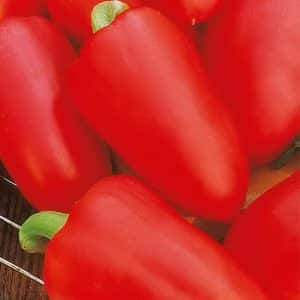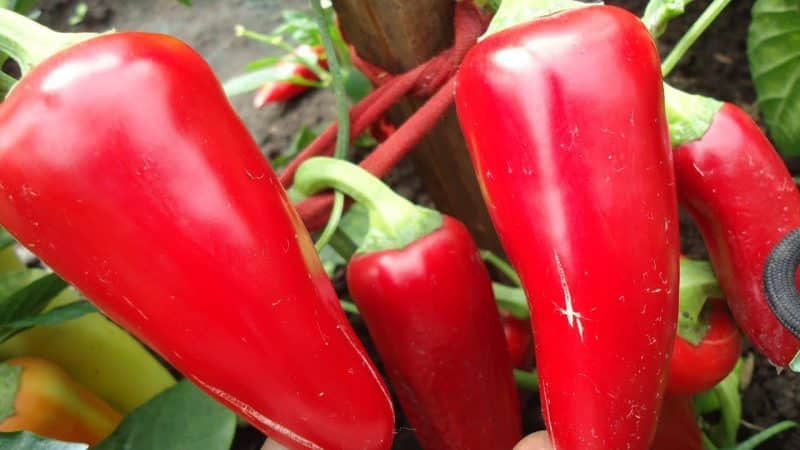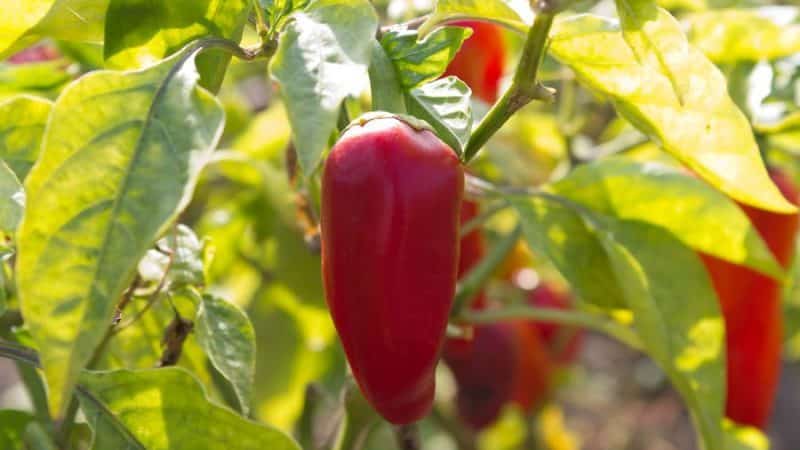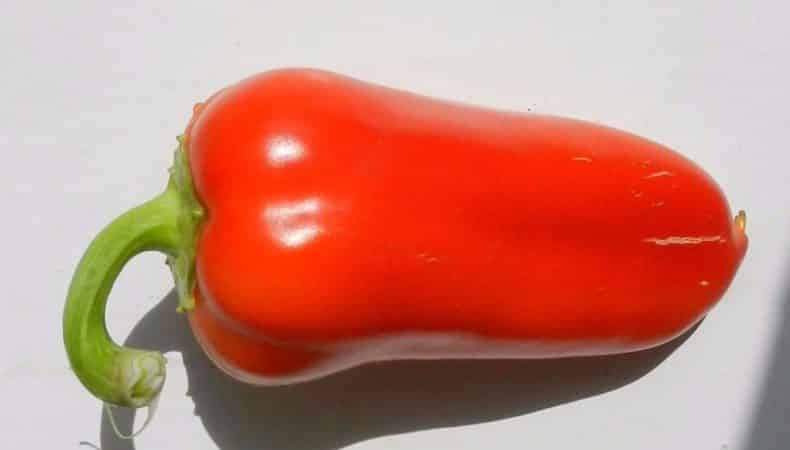Why summer residents love “Swallow” pepper: characteristics and description of the variety, its pros and cons
The abundance of varieties of vegetable seedlings on market shelves is wonderful. But choosing a crop that will bring a rich harvest, quickly adapt to the environment and will not get sick is not easy. The article will help solve the problem of choosing a vegetable such as bell pepper.
We bring to your attention the Swallow variety - this article will tell you what the advantage is, how to grow it, what the yield is.
What type of pepper is this?
One of the representatives of the nightshade family is sweet pepper. Many breeders are working to improve its quality characteristics. There are varieties of pepper that were bred many years ago, back in the USSR, but to this day are in demand among gardeners.
Swallow is just one of them. The variety was included in the State Plant Register back in 1974. It has improved growth rates, is resistant to diseases, and shows excellent productivity. Bred by Moldovan breeders.
Characteristics and description of the variety

The Sweet pepper variety Lastochka is planted in open soil in many regions of Russia: from the Central Black Earth to the Trans-Urals. The swallow was selected for industrial food production. But it is successfully grown by summer residents in their garden plots.
The Lastochka variety produces red fruits. These peppers are the leaders in vitamin C content. 100 g of this variety contains the daily requirement for humans.
The calorie content of sweet bell pepper is only 26 kcal, so people watching their weight are happy to include it in their diet.
Main characteristics of the variety:
- a small bush with a single trunk about 65 cm high, cascading in shape;
- with a large number of fruits, the bushes are tied to a support to avoid damage;
- mid-early ripening period, ripens in the third or fourth month from the moment of planting in the ground;
- yield – up to 5 kg per 1 m2;
- used for domestic needs and on an industrial scale;
- It tolerates changes in air temperature well and does not require special care.
Distinctive features
The swallow differs from its predecessor parents in several ways:
- tall bushes - grows up to 70 cm;
- high productivity;
- early fruit ripening.
Fruit characteristics, yield
Pepper Swallow got its name due to the shape of the fruit. At the base the vegetable is cone-shaped, reminiscent of a swallow's beak.
The shape of the fruit is clearly visible in the photo.

The main characteristics are:
- the fruits are large, fleshy, up to 10 cm long, wall thickness can reach 7 mm;
- The pepper is cone-shaped, the skin is smooth;
- the weight of the fruit is approximately 85 g, larger vegetables also grow - up to 100 g;
- ripe peppers are bright red, technically ripe vegetables are bright light green, 20–30 days pass between ripening periods;
- the taste is sweetish, with sourness and a slightly perceptible bitterness.
The productivity of the variety is high. If you properly care for the crop, you can get up to 6 kg per 1 m2. The fruits ripen almost simultaneously.
Preparation for cultivation
It is advisable to sow Swallow pepper seeds in open ground only in the southern regions. In the northern regions of the country, the crop is grown using seedlings.Seeds for seedlings are sown two months before planting seedlings in open soil.
Seeds are planted in the last week of February - the first ten days of March. Pepper Swallow is grown both in open ground and in greenhouses. Seedlings are planted in a permanent place at the end of May, in a greenhouse - in the third decade of April.
Attention! Since pepper seeds take longer to germinate than tomatoes and cucumbers, consider the timing of planting the seeds.
Preparing seeds for sowing
Seeds purchased in specialized garden stores are not processed; this is done by the manufacturer. If the planting material was collected from the previous harvest, then the first step is to select suitable seeds and activate them:
- I select whole, uniform seeds, without damage or defects;
- disinfection is carried out with a 1% manganese solution or with chemicals designed to combat fungi (soak the seeds for 20 minutes, then wash them);
- to speed up germination, soak the grains in growth stimulants (Epin-extar, Kornevin, Sodium Humate, Zircon, Silk);
- germinate the seeds on cotton wool moistened with water (cotton pads are used for convenience), cover the container with plastic film or a bag and make sure that the cotton wool is constantly damp;
- ventilate the seed several times a day - remove the film and put it back on the container.
Growing seedlings
When the seeds on the cotton pads begin to germinate, they are planted in soil treated with hot steam. This is done to destroy harmful bacteria, fungi, algae, and nematodes. Prepare the soil for planting peppers yourself - mix turf, river sand, and sawdust in equal parts. You can purchase ready-made soil, then there is no need to pre-treat the soil.
There is another option for sowing pepper seeds - in peat tablets or directly in separate cups filled with soil. This method will allow you to avoid a procedure that is traumatic for young seedlings - picking.
When the bushes grow, they are planted in the ground along with tablets or from cups with a lump of earth where the roots are located. This option for obtaining seedlings will help the plants quickly take root in a new place and speed up the ripening of fruits.
Planting pepper
Step-by-step instructions for sowing seeds look like this:
- Seeds are placed in a common container to a depth of 1.5 cm with a distance of 2 cm from each other.
- When planting in separate containers, the sprouted seeds are placed one in each tablet or cup. Those that have not sprouted are sown in two pieces. After germination, the excess plant is carefully trimmed and not pulled out.
- When two or three leaves grow from the seeds in a common box, the plants are planted - transplanted into containers with cells or cups (the volume should not be less than 0.5 l), trying not to damage the root system.
- The volume of each glass should not be less than 0.5 liters - the roots of sweet peppers love freedom.
Further care
To get healthy, strong seedlings, planting conditions must be created.
The plant needs sunlight at least 12 hours a day. If it is not enough, then use phytolamps. The temperature regime recommended for the heat-loving vegetable is: +25°C during the day, not lower than +20°C at night.
Attention! The heat-loving variety stops growing if the air temperature is below +13°C.
Do not allow the soil to dry out. Water the seedlings with settled warm water.
Swallow seedlings are fed twice. Use mineral fertilizers that do not contain chlorine. Fertilizing is combined with watering.
Before planting, pepper seedlings are hardened off and periodically placed in the open air, gradually increasing the residence time. Seedlings that have undergone the hardening procedure take root faster.
Features of growing the variety and possible difficulties

Pepper is a heat-loving plant. In regions where the climate is cool, it is covered with film so that the growing crop does not waste energy fighting stressful temperatures.
Lack of water affects the amount of harvest - the fruits grow small and do not correspond to varietal characteristics. A large amount of moisture prevents the absorption of fertilizers, which also affects the yield. During the dry season, peppers are watered regularly as soon as the top soil is dry to a few centimeters deep. Irrigate the crop from a watering can, trying to prevent water from getting on the leaves.
Every two weeks, peppers are fed with mineral fertilizers. Nitrogen is used with caution so that vegetables do not grow leaves instead of fruits. They begin fertilizing about two weeks after planting in the beds, when the plant has not yet bloomed. The crop is fed by alternating organic fertilizers with inorganic ones.
Important. To preserve moisture, which prevents the pepper from overheating in hot weather and from overcooling in cold weather, the soil is mulched. Remove weeds and loosen the soil.
Typical diseases and pests
Pepper Swallow suffers from the same diseases as other vegetables of the nightshade family: late blight, blackleg, fusarium, stolbur. Pests that cause great damage to the crop: chafer larvae, whiteflies, aphids, spider mites.
Methods of fighting insects are used both industrial and folk: they are sprayed with fungicides “Fitoverm”, “Aktellik”, “Karbofos” or use decoctions of onion peels, dandelion inflorescences, and garlic.
Advantages and disadvantages of the variety
Swallow pepper has many advantages over other varieties. Thanks to these qualities, it is widely used by gardeners and summer residents in their garden plots:
- leader in the amount of harvested crops;
- adapted to the first frosts in summer and autumn;
- seeds for planting are used from your own garden;
- fleshy fruit with a pleasant taste.
The fruits are eaten fresh, made into salads, preserve.
Among the disadvantages, the susceptibility of the variety to typical vegetables of the nightshade family is noted. illnesses and pests. In regions with an unstable climate, the Lastochka variety is grown only in greenhouse conditions.

Reviews
The variety, which has more than 50 years of cultivation history, can boast only positive reviews. It is chosen by both experienced gardeners and those just starting to master gardening wisdom.
Anna, Voronezh: «I have been growing Swallow for a long time. It is stored for a long time and has an excellent taste. Maintenance does not require much time. The main thing is to water regularly and pinch off excess leaves in time. The fruits are large. I recommend it for gardeners who have no experience in cultivating vegetables.”
Sergey, pos. Alexandrovka: “The yield is excellent! The taste is pronounced, the fruits are fleshy, 80 grams each. I liked the fact that I had to take care of the Swallow only the first time, when there were frosts on the soil. For those who are constantly engaged in growing vegetable crops, pepper of this variety is simply irreplaceable.”
Svetlana, Mtsensk: "Martin - variety, which I recommend to all pepper lovers. It's a bit of a hassle, but it has plenty of benefits: a tasty, juicy vegetable. The sprouts sprout simultaneously, together. I feed it with mullein and the pepper grows wonderfully. I am reaping a rich harvest. The whole family loves salads, lecho, and winter preparations from Lastochka.”
Conclusion
All the characteristics of the Swallow pepper indicate that the variety does not require special growing conditions, is resistant to many diseases, weather changes, and is well preserved. Sweet peppers have improved growth rates and high yields. The fact that this crop has been grown for more than half a century suggests that Lastochka is the best variety of pepper. Try growing original-shaped fruits in your garden. Judging by the reviews from gardeners, you will not regret your choice!